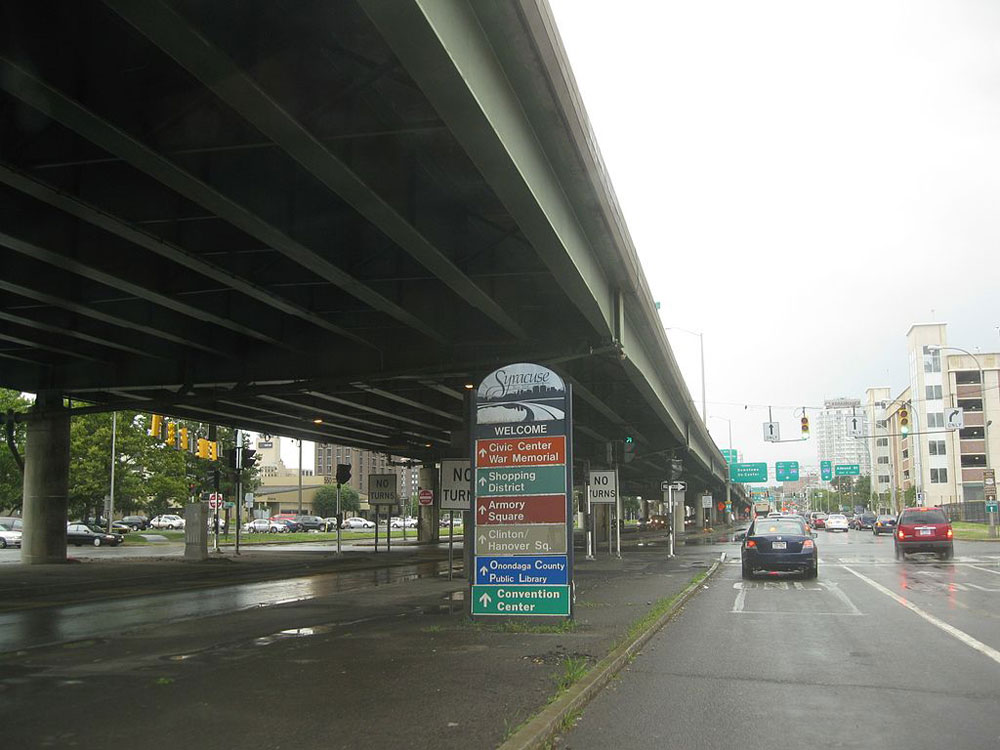
July 30, 2019; Jalopnik
Jalopnik recently published a story on the decade-long battle over a crumbling Interstate 81 in Syracuse, New York. The New York Civil Liberties Union (NYCLU) has stepped in to amplify the voices of residents typically left out of the discussion.
The story of Interstate 81 is an all-too-familiar story in America. Urban renewal, which novelist James Baldwin aptly labeled “negro removal” in 1963, hit the country, and highways cut through thriving neighborhoods, typically neighborhoods of color, making way for the cars of postwar suburbs—in effect, segregation reinforced via government-funded infrastructure.
Now, as that infrastructure deteriorates, cities are weighing different options. Syracuse is one of these; there has been almost a full decade’s worth of back-and-forth on what to do with Interstate 81.
The highway, part of Interstate 81 which now runs from Tennessee to Canada, contains a 1.4-mile elevated section called a viaduct right along the former 15th Ward and the current Syracuse neighborhood, the South Side, which is still predominantly African-American and has a median household income just under $23,000.
But the viaduct—which was completed in the early 1960s along with a junction to I-690 right at the heart of Syracuse, combining for over one million square feet of deck space—is at the end of its useful life, like many urban highways across the country from that time. It will soon cost too much to maintain. Something needs to be done.
The main two options are to repair and rebuild the viaduct or tear it down and replace it with a street grid system. The latter would have the dual effect of making that part of the city more accessible to pedestrians, cyclists, and public transit, but also could draw in new residents, raising the specter of gentrification.
Sign up for our free newsletters
Subscribe to NPQ's newsletters to have our top stories delivered directly to your inbox.
By signing up, you agree to our privacy policy and terms of use, and to receive messages from NPQ and our partners.
A recent report from the New York Department of Transportation (NYDOT) recommends tearing down the viaduct and rerouting traffic around the city. Local advocacy groups, including SAVE 81 and owners of area hotels and malls, publicly oppose this option, touting the potential increased traffic, longer commute times, etc. (They also say there’s no unusual health negatives for children playing under highways.) Such groups have spent time and money lobbying against the grid.
Debates over freeway removals can take years; after an earthquake damaged Seattle’s Alaskan Way Viaduct in 2001, it took about 18 years for removal to commence. And removal appears to be no less contentious in Syracuse.
WRVO has been reporting on this process since 2012. Their first article on the site details the possibility of getting rid of the viaduct and says a plan would not be in place until 2017. They reported on candidates taking up the issue in 2014. In 2015 and 2016, some different options were considered, including a tunnel. But in 2017, WRVO published an article that really struck to the heart of the debate: The difference in opinion lies in the gap between urban and suburban residents. In the past, the urban position wasn’t even considered. According to Jalopnik, several people spoke out and showed up to protest the urban renewal project in 1957. However, “no amount of pleading or appeals to reason seemed to work. By 1965, more than 90 percent of the 15th Ward had been bulldozed.”
So, how can Syracuse ensure everyone that all voices be considered? In 2010, an NPQ article on urban renewal called nonprofits “boots on the ground” as a positive factor rivaling opposition money and advocating for urban neighborhoods. “There’s a nonprofit success story lurking here,” author Rick Cohen said of Detroit’s battles post-urban renewal.
NYCLU’s intervention might help generate a nonprofit success story in Syracuse. In March 2017, the organization published a brief history of Interstate 81’s disastrous effects on communities. “The people who stand to gain and lose the most by what comes next must have their voices heard,” they wrote. In November of 2017, NYCLU hosted an event with a panel and discussion on the issue. Since then, NYCLU has continued to engage members of Ward 15 in Syracuse.
As Jalopnik covers, NYCLU continues to help uplift the voices of those who would feel the greatest impact from this decision through canvassing and events. According to an article published by South Side’s (Ward 15 in Syracuse) The Stand, “The group is working to determine how these families will maintain their civil liberties throughout the entire process.”
At this time, those who want the freeway torn down and replaced by a community grid seem to have the advantage, though planning is still in early stages. Meanwhile, NYCLU continues to host events to insist in resident engagement. Although there’s no firm resolution just yet, this time, at least the conversation isn’t so one-sided.—Sarah Miller













